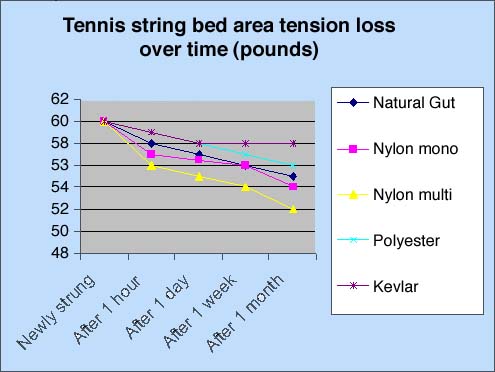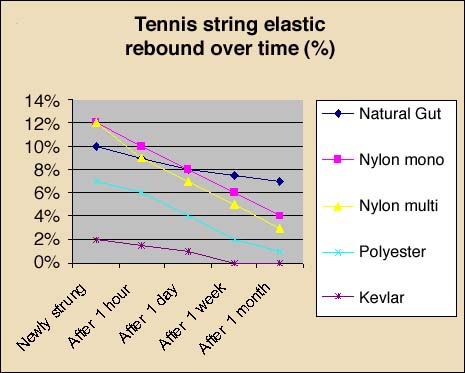|
|
 |
|
What makes natural gut string so good?
IntroductionThere is no single factor that makes it stand out, in fact you can get better individual characteristics from a variety of materials. It is how well it melds them all together that makes it special.
How durable is natural gut?There are two types of durability we should talk about; resistance to breakage, and performance life. Most synthetic strings are very tough, have a very high tensile strength, and normally are significantly more break resistant. However, gut has a different set of elasticity characteristics, which makes it resist fatigue much better. Typically, natural gut has a much longer performance life, in fact they usually play well up to the time they break. Synthetic gut strings will normally lose performance very rapidly, but will stay in the racquet without breakage for a very long time. One Pro summed it up very well, he said, “Gut has the integrity to retire before its game starts to suffer." How do natural guts differ?The quality of their raw materials, the number of plies and how many twists, plus the quality of their internal bonding, the amount of damage that was done by chemical processing, the type of coating, and physical properties like resilience, tensile strength and abrasion resistance. In other words they can be as different as black and white. In the final analysis it boils down to performance and performance life. Through a combination of chemistry and physics we can make a nearly infinite number of compromises between power, durability, elasticity and tensile strength. Our PACIFIC natural gut strings are designed with the philosophy that they should have very high performance that remains reasonably consistent throughout their playing life, while exhibiting good wear resistance. So far, this is the same as everyone else. We also believe that the string technology has to change to keep pace with racquet technology and the needs of the player. Not too long ago we were looking for every conceivable way to gain more power. The fact that top players are stringing natural gut at 70 pounds and higher in order to maintain control told us that we may have gone too far. The string had to be more closely tuned to modern racquet technology in order to be useable. We think it is a better idea to design a string that can give the desired level of power and control at reasonable tensions. By doing this we have been able to improve ball feel, decrease shock to the player, decrease tension loss, and improve durability — all this while maintaining the power players want and need. How do PACIFIC™ natural gut strings compare to the competition?Our best competitor produces an excellent product with a somewhat different philosophy. They put their emphasis on power, we have aimed at consistent performance. When they are first strung, the racquet is extremely powerful, this rapidly settles down to a plateau of excellent playability, then into a fairly rapid performance decline. The high initial power leads many players to use very high string tensions in order to maintain control. We have chosen to forgo the extremely high initial performance for more uniform playability and longer performance life. By optimizing our power to today’s racquets we provide control at 55 to 60 pound string tensions. One is not better, just clearly different. How does natural gut compare to synthetics?Synthetic strings are made from a wide variety of materials with an even larger number of construction techniques. To answer this fully would take about 96,000 pages, and you probably are not that interested. The collagen triple helix gives natural gut a balance of characteristics that provide excellent feel, power and control while absorbing many of the shocks and vibrations that are often blamed for arm and shoulder problems. Synthetics can be engineered to excel in some, or even most of these characteristics, but to date none have it all. From the point of view of performance life, natural gut is a little like a Energizer™ bunny, it just keeps going and going and going — until it dies.
A stringer has another and more accurate way of coming to this answer when old strings are cut out of the racquet. Typically, strings which have performance life left in them will “snap back” and shorten when they are cut or broken. Dead strings will not. As a general rule, natural gut strings still have the ability to snap back a great deal when they break, nylon has a little, polyester has less still, and Kevlar™ has nearly none. Please understand that these charts are based on a compilation of data, and do not represent any one type or brand of string, they simply illustrate a point. Why do I need it?Natural gut not only provides superior playability, it is less fatiguing to play with. In the final analysis it will improve your game and make tennis more fun. About 75% of the ATP, the finest and tightest fisted professional players in the world, use natural gut — and most pay for it. Does natural gut help reduce medical problems such as tennis elbow?Natural gut definitely is less fatiguing to play with. Most players who use it say it is far easier on their body than synthetics. The medical profession and the press often voice this opinion as well. It must also be said that many people have long and happy careers using harsh feeling synthetics. While there is no proof that natural gut produces a health benefit, most of the people who use it do so because they believe it allows them to play injury free. Try it and see for yourself. What string gauges are available?Natural gut is available in a full variety of gauges. Because of it’s excellent feel and ball bite players often choose slightly heavier gauges than they would use in synthetics. Most recreational players use 15L or 16, high level players 16L or 17. Remember thinner gauges give higher performance and shorter life. What racquet sports can benefit from natural gut?Badminton and squash players benefit as much from natural gut as tennis players do. Badminton strings are very fine 2½ to 3½, Squash 7½ to 8½. What about hybrid string sets??In spite of its outstanding characteristics, natural gut is not all things to all people. Some want more durability, others finer gauges, still others want less liveliness. By putting one type of string in the mains and another in the crosses a tremendous amount of fine-tuning can be achieved. Natural gut and Kevlar™ — Kevlar™ is a very strong string with very little elasticity. Its strength allows it to be used in fine gauges that provide excellent ball bite. Unfortunately, it does not provide very good feel, and it is very hard on the player. Many top professionals use 1.10 or 1.20 mm Kevlar™ in the main strings and a slightly heavier natural gut in the crosses. The result is fine playing, and more durable, as well as more player friendly. We have had many very successful natural gut hybrids including soft nylons and Zyex™ strings. Cut some sets in half and experiment, you may love it. |
|
HOME | OUR GUT | OUR NYLON | OUR POLY | TIPS | RAVES | LINKS | SEARCH |

